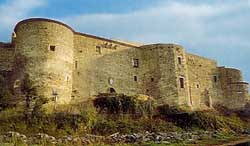Vibo Valentia
Vibo Valentia | |
|---|---|
| Comune di Vibo Valentia | |
 Panorama of Vibo Valentia | |
| Country | Italy |
| Region | Calabria |
| Province | Vibo Valentia (VV) |
| Frazioni | Bivona, Longobardi, Piscopio, Porto Salvo, San Pietro, Vena Inferiore, Vena Media, Vena Superiore, Triparni, Vibo Marina |
| Government | |
| • Mayor | Nicola D'Agostino |
| Area | |
• Total | 46.2 km2 (17.8 sq mi) |
| Elevation | 476 m (1,562 ft) |
| Population (31 March 2010)[2] | |
• Total | 33,819 |
| • Density | 730/km2 (1,900/sq mi) |
| Demonym | Vibonesi |
| Time zone | UTC+1 (CET) |
| • Summer (DST) | UTC+2 (CEST) |
| Postal code | 89900, 89811 |
| Dialing code | 0963 |
| Patron saint | St. Leoluca |
| Saint day | 1 March |
| Website | Official website |


Vibo Valentia (Italian: [ˈviːbo vaˈlɛntsja] ) is a city and comune (municipality) in the Calabria region of southern Italy, near the Tyrrhenian Sea. It is the capital of the province of Vibo Valentia, and is an agricultural, commercial and tourist center (the most famous places nearby are Tropea, Ricadi and Pizzo). There are also several large manufacturing industries, including the tuna district of Maierato. Very important for the local economy is Vibo Marina's harbour.
History
Vibo Valentia was originally the Greek colony of Hipponion. It was founded, probably around the late 7th century BC, by inhabitants of Locri, a principal city of the Italian Magna Graecia, south of Vibo Valentia on the Ionian Sea. Diodorus Siculus reports that the city was taken in 388 BC by Dionysius the Elder tyrant of Syracuse, who deported all the population. The population came back in 378 BC, with the help of the Carthaginians. In the following years Hipponion came under the dominion of the Bruttii, who controlled most of Calabria. After the town fell to Rome, the name was Latinized to Hipponium. The town became a Roman colony in 194 BC with the name of Vibo Valentia. After a phase of prosperity during the late Republic and early Empire, the town was almost completely abandoned after the fall of the Western Roman Empire.
In 1070 the Normans built a castle at the site of the old Acropolis and in 1235 a new city was established by Frederick II, Holy Roman emperor and king of Sicily, with the name of Monteleone. The city got back the old Roman name of Vibo Valentia only in 1928.
Bishopric
A Diocese of Vibo Valentia was established in 451AD and suppressed in 1083AD when it was incorporated into the Diocese of Mileto.[3][4] In 1968AD it was restored as a Titular See and it remains a titular see of the Roman Catholic Church.[5] The only known bishops are:[6]
- Aldo Cavalli current
- Luciano Angeloni (1970 -1996)
- Andreas Rohracher (1969 - 1970)
Main sights
- Norman-Hoehenstaufen Castle, located most likely on the site of Hipponion acropolis, and built around 1000. For its construction materials from the Greek temples nearby were used. It was damaged by an earthquake in 1783. Today the castle is home to a state museum.
- Walls of Hipponion, including about 350 metres (1,150 ft) of remains and foundations of eight towers, each with an estimated height of 10 metres (33 ft).
- Church of Santa Maria Maggiore e San Leoluca (Cathedral), built in the 9th century over the remains of a Byzantine basilica. It has an 18th-century marble high altar with a 16th-century sculpture of "Madonna della Neve", and a Renaissance triptych.
- Church of Santa Ruba (c. 1000), built by Pope Callixtus II. It has a large cupola in Oriental style.
- Church of the Rosario (c. 1337), located over a Roman temple. Originally in Gothic style, it was remade after the 1783 earthquake.
Twin towns
 Corleone, Palermo, Sicily, Italy
Corleone, Palermo, Sicily, Italy Ruda Śląska, Poland
Ruda Śląska, Poland Vrnjačka Banja, Serbia
Vrnjačka Banja, Serbia Ituzaingó, Argentina
Ituzaingó, Argentina
References
- ^ "Superficie di Comuni Province e Regioni italiane al 9 ottobre 2011". Italian National Institute of Statistics. Retrieved 16 March 2019.
- ^ "Popolazione Residente al 1° Gennaio 2018". Italian National Institute of Statistics. Retrieved 16 March 2019.
- ^ G. A. Loud, The Latin Church in Norman Italy (Cambridge University Press, 20 Dec. 2007)p191.
- ^ Joseph Bingham, Origines ecclesiasticæ Volume 2(Printed for William Straker, 1834) p371.
- ^ Vibo at Catholic Heirachy.org.
- ^ Vibo Valentia at GCatholic.org.
- The Columbia Encyclopedia, Sixth Edition. Columbia University Press. 2001. [1]
- The Princeton encyclopedia of classical sites; Stillwell, Richard. MacDonald, William L. McAlister, Marian Holland. Princeton, N.J. Princeton University Press. 1976. ISBN 0-691-03542-3 [2]
External links

